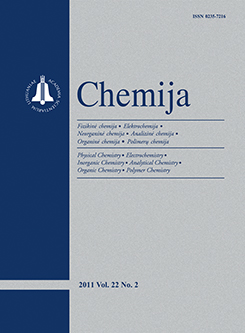 ISSN 0235-7216 ISSN 2424-4538 (online) |
2009 m. Nr. 3 The influence of micromycetes on the corrosion behaviour of metals (Cu, Zn) in environments polluted with organic substances
The micromycetes of five species such as Chrysosporium merdarium, Penicillium cyclopium, Arthrinium phaeospermum, Cladosporium herbarum, Aspergillus niger, grown on metallic plates exposed to natural conditions have been investigated. Their specific ecological and biological peculiarities have been determined. Cu (>99.5%) and Zn (98.5%) plates 100 × 150 × 3 mm in size were contaminated with the mentioned fungi and placed into Petri dishes on a nutrient medium imitating organic pollution. It has been determined that Cu and Zn react differently to the impact of micromycetes. The influence depends on the capacity of fungi to develop on the metal surface and produce metabolites stimulating changes in polarization resistance and to destruct the surface. Aspergillus niger fungi proved to be the most active destructors of copper surface, while Arthrinium phaeospermum was the most active destructor of zinc. Chrysosporium merdarium is able to diminish the roughness of Zn surface. This fact is especially important in the first steps of metal and coating corrosion. The influence of various strains of the same fungi on metals was noted to be significantly different; therefore, it is important to determine specific strains or mycocommunities and describe their physiological abilities in order to evaluate the aggressiveness of fungi or their capability to produce metabolites able to suppress metal corrosion. Keywords: copper, zinc, micromycetes, metabolites, corrosion, changes of surface |
Issues:
2017 - Vol.28 No. 1, No. 2, No. 3, No. 4 2016 - Vol.27 No. 1, No. 2, No. 3, No. 4 2015 - Vol.26 No. 1, No. 2, No. 3, No. 4 2014 - Vol.25 No. 1, No. 2, No. 3, No. 4 2013 - Vol.24 No. 1, No. 2, No. 3, No. 4 2012 - Vol.23 No. 1, No. 2, No. 3, No. 4 2011 - Vol.22 No. 1, No. 2, No. 3, No. 4 2010 - Vol.21 No. 1, No. 2-4 2009 - Vol.20 No. 1, No. 2, No. 3, No. 4 2008 - Vol.19 No. 1, No. 2, No. 3-4 2007 - Vol.18 No. 1, No. 2, No. 3, No. 4 2006 - Vol.17 No. 1, No. 2-3, No. 4 2005 - Vol.16 No. 1, No. 2, No. 3-4 2004 - Vol.15 No. 1, No. 2, No. 3, No. 4 2003 - Vol.14 No. 1, No. 2, No. 3, No. 4 2002 - Vol.13 No. 1, No. 2, No. 3, No. 4 2001 - Vol.12 No. 1, No. 2, No. 3, No. 4 |